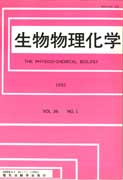All issues

Successor
Volume 36 (1992)
- Issue 6 Pages 323-
- Issue 5 Pages 249-
- Issue 4 Pages 211-
- Issue 3 Pages 155-
- Issue 2 Pages 83-
- Issue 1 Pages 3-
Volume 36, Issue 6
Displaying 1-7 of 7 articles from this issue
- |<
- <
- 1
- >
- >|
-
Nobuya Hashimoto1992Volume 36Issue 6 Pages 323-328
Published: December 15, 1992
Released on J-STAGE: March 31, 2009
JOURNAL FREE ACCESSDownload PDF (670K) -
Motomu Shimizu, Takao Iwaguchi1992Volume 36Issue 6 Pages 329-337
Published: December 15, 1992
Released on J-STAGE: March 31, 2009
JOURNAL FREE ACCESSDownload PDF (968K) -
Wolfgang Schütt1992Volume 36Issue 6 Pages 339-345
Published: December 15, 1992
Released on J-STAGE: March 31, 2009
JOURNAL FREE ACCESSDownload PDF (850K) -
Domagoj Sabolovic, Nobuya Hashimoto1992Volume 36Issue 6 Pages 347-351
Published: December 15, 1992
Released on J-STAGE: March 31, 2009
JOURNAL FREE ACCESSDownload PDF (534K) -
1992Volume 36Issue 6 Pages 353-380
Published: December 15, 1992
Released on J-STAGE: March 31, 2009
JOURNAL FREE ACCESSDownload PDF (16158K) -
Teruyo Watanabe, Kunihiko Kobayashi, Tomoya Takahashi, Kazuo Yoda, Nao ...1992Volume 36Issue 6 Pages 381-385
Published: December 15, 1992
Released on J-STAGE: March 31, 2009
JOURNAL FREE ACCESSThe serum from a 66 year-old woman (F.T.) with IgA-kappa multiple myeloma displayed two distinct IgA-bands at α2 region on a conventional cellulose-acetate membrane electrophoresis. Two molecular forms of IgA, a high molecular weight IgA (P1) and a low molecular weight IgA (P2), each of which corresponded to two bands on the cellulose-acetate membrane, were separated from the serum of the patient by gel-filtration. Their molecular characteristics, subclasses and allotypes were investigated by electrophoresis under reducing or non-reducing conditions, reactivity with an IgA 1-specific lectin, jacalin, and susceptibility to an IgA 1-protease. These two IgAs (P1 and P2) had the same isotype and kappa chains, and the electrophoretic mobility of P1 was converted into that of P2 on conventional agarose gel electrophoresis after reduction of disulfide bonds. They lacked reactivity with jacalin and were resistant to IgA 1-protease. Thus, both IgAs were identified to be IgA2 subclass with different molecular forms. Upon SDS-PAGE under non-reducing condition, both IgAs released dimeric light chains. This indicates that both IgAs lacked disulfide bonds between heavy and light chains, but had those between two light chains, a characteristic stractural feature of IgA2, A2m (1) allotype. It was thus concluded that the patient was IgA myeloma of IgA2, A2m (1) allotype with two molecular forms. This would be the first report describing the precise analysis of the IgA2, A2m (1) myeloma protein from Japanese patient.View full abstractDownload PDF (5069K) -
Shunsuke Migita, Miyako Takegami, Jiro Okumura, Yasuo Nagai, Sumiko Ha ...1992Volume 36Issue 6 Pages 387-394
Published: December 15, 1992
Released on J-STAGE: March 31, 2009
JOURNAL FREE ACCESSM-components of immunoglobulin in the sera have been classified by immunoelectrophoresis, a delicate and time consuming procedure. A new method, affinity absorbed electrophoresis, was described with advantages of easy, rapid (40min) and economical procedure. Instead of antisera, Omnibind A/G, Jacalin and dithiothreitol as specific reagents for IgG, IgA and IgM, respectively, were taken into three microtips and lyophilized. Each 10μl sera was taken into these tips and then applied for automatic electrophoresis. Either disappearance, or decreased concentration, or more rapid or slower migration of M-component than original was estimated as positive reaction with the reagents. Then the heavy-chain classes of M-component were discriminated. Three hundred eighty-four M-components out of 416 sera (92.3%) were easily identified. Corresponding patterns of the other 32 sera containing IgD, IgA2, L-chain and heavy-chain M-component, respectively, were also described, but not distinctive. However, affinity absorbed electrophoresis is good to identify M-component class as a routine analysis.View full abstractDownload PDF (5282K)
- |<
- <
- 1
- >
- >|